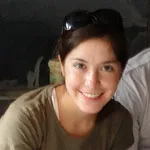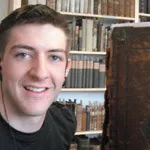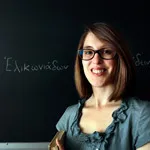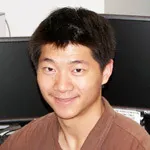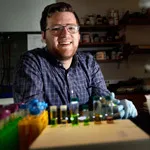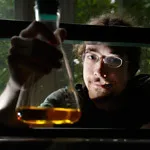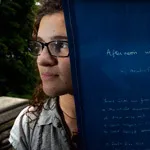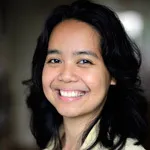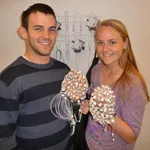Students as Scholars, Sharing New Knowledge Far and Wide
July 9th, 2012 Carol Brevart-DemmOne of the advantages of Swarthmore, with its tradition of academic rigor and high performance, is that the faculty can focus entirely on their undergraduate students. These impressive teacher-scholars — whether in the sciences, social sciences, the arts, or engineering — provide students the opportunity to work alongside them, devising and conducting experiments and producing literary and scholarly papers that result in presentations at academic conferences or publications in journals. Below are the accomplishments of just a few of the College's student scholars, representing the fields of comparative literature, biochemistry, French, engineering, classics, biology, linguistics, history, economics, and psychology.
Arielle Bernhardt '12
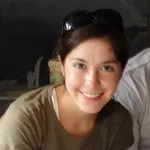
Arielle Bernhardt '12
honors economics and sociology and anthropology
Vancouver, Canada
Arielle co-authored, with Michelle Liu '11 and Frank and Betty Barr Professor of Economics Stephen Golub, a report for the United Nations Conference on Trade and Development (UNCTAD). Focused on Least Developed Countries (LDCs) during the past decade, the paper is intended for use by United Nations member states as they plan policies and strategies for the future.
"This was both a very challenging and rewarding experience for me," Arielle says. "I was tasked with determining which factors led to the success of some countries and the stagnation of others. This required analyzing data on institutions, public policies, and the business environment, and determining which factors were most important for each country.
"Working in conjunction with Professor Golub made the task much easier," she adds. "I appreciated that he helped guide my analysis but gave me freedom to pursue arguments of my own choosing."
Bernhardt later spent a semester in Senegal and stayed for the summer conducting research for her thesis on microcredit and informal finance. "Our findings on Senegal's growth experience informed my own research questions and approach," she says.
Arielle says her research with Golub, who has co-authored a number of recent papers with students for use by UNCTAD, helped to spark her interest in economic development and in the ways in which low-income countries can spur growth. Shortly after graduating, she headed to the Philippines to work as a research assistant for the Innovations for Poverty Action.
Benjamin Goossen '13
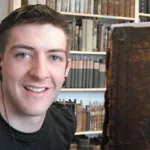
Benjamin Goossen '13
honors history and German studies
Topeka, Kan.
This fall, Ben published an article which examined gender and immigrant culture in Kansas History: A Journal of the Central Plains. Titled "Like a Brilliant Thread": Gender and Vigilante Democracy in the Kansas Coal Field, 1921-1922," the article had its origins in a paper he wrote for a first-year seminar on the American West taught by Professor of History Allison Dorsey.
"During one particularly divisive coal strike in 1921," Ben says, "several thousand women of the various mining camps in southeast Kansas formed a vigilante militia that shut down 60 mines that were operating despite the strike. Their march made national headlines, as well as a few major political enemies. My goal was to demonstrate the political underpinnings of the women's actions and to show that their march was not a random act of mob violence but rather the creation of a new democratic space, which the participants justified through the rhetoric of American social values and labor rights."
Ben says he wrote the paper because it was a fascinating topic about which he knew little. "I had no idea that Kansas played such a prominent role in national labor history," he says, "and I've received a lot of positive feedback on it. A number of people I know around Kansas subscribe to the journal, and many have written me notes with reflections, personal stories, and additional tidbits of history. That's definitely been one of the coolest things to see. When you dig up a little bit of history, it gets people interested and talking, and, pretty soon, more great stories come to light."
Most of all, he says, he enjoyed the research process. "Checking out various archives in Kansas was a blast," he says, "and I took a great trip down to Pittsburg to see the sites from the march - the hotel where the sheriff stockpiled weapons and deputized WWI vets; the road that women walked to confront mine operators; the areas patrolled by National Guard troops with rifles and machine guns. I also met people whose family members had participated in the march and who celebrate the march with plays and reenactments. It was really exciting to see how personal and meaningful this particular history is for the descendants of those who lived it."
Goossen, recently awarded a Beinecke Scholarship, spent this spring in Germany conducting research for his senior history thesis on minority religious groups and the rise of German nationalism in the 19th century. "My experience with the Kansas history project definitely helped with the research process for my current project," he says, "and has encouraged me to pursue more historical scholarship in the future."
Amanda Klause '12
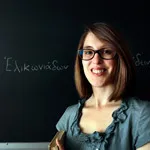
Amanda Klause '12
honors Greek and Latin
Middletown, Ct.
Amanda presented a paper at the Annual Meeting of the Classical Association of the Atlantic States (CAAS) in Baltimore in October. She based her talk on work she had written for Associate Professor of Classics Grace Ledbetter's course on archaic and lyric poetry.
"In the paper, I explore the ways in which the narrator of Hesiod's Theogony systematically relegates chthonic [relating to the underworld] female deities to inferior positions in the Olympian hierarchies," she says. "It relies heavily on French Structuralism, particularly Marcel Detienne's famous formulation of the poet in Archaic Greece as a 'Master of Truth.'
"Presenting the paper was a really wonderful opportunity," adds Klause, who will begin work on a Ph.D. in classics at Princeton University in September. "I was pleasantly surprised by the extremely positive reactions to the talk. I got to meet a number of classicists whose work I've read and admired and got to hear what they had to say about my own work."
Tianyu "Tom" Liu '12
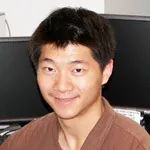
Tianyu "Tom" Liu '12
biology
Collegeville, Pa.
Tom is first author, with Helen Hougen'10 and Professors of Biology Amy Cheng Vollmer and Sara Hiebert Burch, of a paper on gut bacteria published in the journal Anaerobe this spring. This was the first time that Swarthmore biologists have appeared in this publication, a multidisciplinary microbiology journal that provides a forum for research on the biology of anaerobic microorganisms.
"Investigating the connections between the different communities of bacteria in the gut and the health of the host, such as those between obesity and inflammatory bowel disease, is a rapidly developing new field," Tom says. "We looked at whether the different types of fatty acids consumed by the host would influence the communities of gut bacteria. We found that all the high-fat diets led to significant shifts in the gut bacteria, closer to the profiles of obese individuals, but that saturated fatty acids had a stronger effect in that direction than either of the two poly-unsaturated fatty acids we investigated."
Liu came to Swarthmore intending to head straight to medical school after graduation. He now has a position at The Advisory Board Company, a D.C.-based health-care and consulting organization, founded by David Bradley '75, that works with hospitals throughout the country.
"Through Amy's mentorship and encouragement," Tom says, "I've been exploring other interests. I really fell in love with work on health-care systems and health-care reform, and I think that now is a particularly exciting time to get into the field and understand some of these issues that hospitals grapple with in this changing environment."
John "Jack" Nicoludis '12
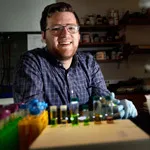
John "Jack" Nicoludis '12
honors biochemistry
Barrington, N.H.
Jack co-authored three articles while at Swarthmore based on research performed in the lab of Assistant Professor of Chemistry and Biochemistry Liliya Yatsunyk.
"I've worked in Liliya's lab for three consecutive summers and have spent many semesters doing either a half or full credit of research," he says. "We work with G-quadruplex DNA - a possible target for cancer drugs - and focus on synthesis and characterization of compounds in hopes of developing a cancer therapeutic."
Jack shared his first credit as a co-author with Yatsunyk and 10 others for an article in Nature Structural & Molecular Biology last spring. "I used the instrumentation and methods we have at Swarthmore to investigate binding of yeast proteins to G-quadruplex DNA," he says.
His second article includes data compiled over three years by a group of researchers, including a number of Swarthmore undergraduates as well as two scientists from the University of Louisville, where Jack spent last May learning how to use data analysis software. The article was published in the journal Biochimie last summer.
Jack's most recent article, and the first for which he is listed as first author, describes a project he began during the summer after his freshman year. It was published in February in Nucleic Acids Research.
This fall, Jack will begin his doctoral studies at Harvard University's Graduate School of Arts and Sciences in the Department of Chemistry and Chemical Biology. "Publishing," he says, "has helped me decide that I want to pursue a graduate education."
Jonathan Martin '12
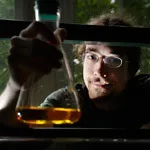
Jonathan Martin '12
engineering
Richmond, Vt.
Last May, Jonathan co-authored a paper that appeared in the proceedings of the 67th American Helicopter Society International Annual Forum. His work showed that flight data gathered from helicopter sensors can be used to predict wear and fatigue.
"The main finding was an algorithm that I developed using MatLab to predict the structural degradation of a helicopter's blades using only data from sensors located on the central part of the rotor," he says. "The point was to eliminate the need to replace helicopter parts before their integrity has been compromised. Currently, helicopter parts are given an estimated amount of service time in flight hours before they must be replaced, but this causes many perfectly good parts to go to waste. The techniques developed in the paper are meant to maximize the amount of time that a part can be used, which saves money without increasing the risk that a part will fail in mid-flight."
Jonathan became involved with this work during an internship with MicroStrain, a Vermont-based company that makes minute sensors with applications from knee implants and civil structures to unmanned military vehicles and automobile engines.
"I got the internship at Microstrain mostly because of my experience with MatLab, a computational software package that's popular with engineers," he says. "Engineers at Swarthmore use MatLab almost on a daily basis, but MicroStrain at the time had nobody on staff with much MatLab experience."
Jonathan says that the most rewarding aspect of writing the paper was being given the opportunity to work on a problem that didn't yet have a solution. "I was developing my own formula," he says, "which for me was a blast."
Amelia Possanza '12
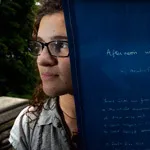
Amelia Possanza '12
honors comparative literature
Pittsburgh, Pa.
Amelia, whose poems have appeared in The Apprentice Writer and Sotto Voce Magazine, says she is fascinated by the stories everyone carries inside. She writes poetry hoping to capture fragments of these stories. For "Afternoon with a Sociopath," which appeared in the most recent issue of Susquehanna Review, she drew inspiration from one of the greatest treasures of world literature.
"Ever since I read Herman Melville's Moby Dick," Possanza says, "I've been fascinated by whales and the old whaling industry. The whalers, and those who wrote about them, have their own very specific language, and I've always wanted to use that in a poem. I'm also really interested in how whales are so huge and alien, yet exhibit so many human qualities.
"A friend of mine once asked me to describe what it feels like to care about other people, and I thought whales would be perfect for exploring that," she adds. "My friend, Tasha Lewis '12, wanted to use the poem in her senior art show, Naturae Curiosa. We went to the library one day and scanned a bunch of whaling images from old books. It was my nerdy dream come true! The poem and the images became a part of her show."
Possanza now lives in New York City, working for Hachette Book Group, and, of course, writing poetry.
Maki Somosot '12
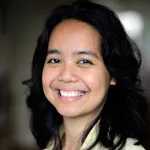
Maki Somosot '12
psychology and French
Manila, Philippines
Maki presented a paper this spring at the annual conference of the American Comparative Literature Association (ACLA) at Brown University. Based in part on her final assignment for Assistant Professor of French Alexandra Gueydan's course La France et Le Maghreb, she presented an examination of the possibility of the "western exotic" - the exotified portrayal of western culture and westernization in Laila Marrakchi's controversial 2005 film Marock.
"I attempt to provide an alternative interpretation to [Palestinian literary theorist and cultural critic] Edward Said's canonical definition of exoticism, which contrasts the inferiority of non-western cultures relative to western culture," Maki says. "Marock's Hollywood style, French financial and logistical support, and the director's transnational background all contribute to the western and Moroccan perceptions that the film is an exotic product." Both western and Moroccan audiences, she adds, essentially engage in a "double exoticism" of the film that invokes an expansion of the "exotic" to apply to both western and non-western cultures.
"Judging by the dynamic discussion that we carried out after [the presentations] and the fact that my paper kept coming up, I think it was well received," Maki says. "I feel incredibly gratified that I was able to present on a subject that I'm passionate about, and I appreciate the opportunity to exchange ideas with others who share the same academic interests. The opportunity to participate and present at ACLA has been one of the heights - if not the very height - of my Swarthmore career."
Somosot hopes to pursue a career in journalism and foreign correspondence, although she envisages the possibility of a doctorate in comparative literature or intercultural psychotherapy in her future, too. She is currently working in New Orleans as a Kaiser Health Media Reporting Summer Fellow at the Times-Picayune.
Cassie Strawser '13 and Brennan Klein '13
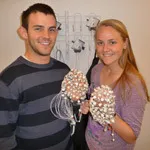
Cassie Strawser '13 and Brennan Klein '13
psychology
Winter Springs, Fla., and Tucson, Ariz.
Cassie and Brennan have been working as a team on research projects under the supervision of Professor of Psychology Frank Durgin. In March, an article they helped co-author appeared in the Journal of Experimental Psychology: Human Perception and Performance.
They described their experiment as follows: "Generally, people aren't good at judging the slope of hills. We'll look at McGill Walk [on campus] and say it has a slope of about 20 degrees, when really it's more like four or five. It turns out the steepest roads in most states are only around eight or nine degrees.
"There's also a lot of research on the fact that people report hills to be steeper when burdened by a heavy backpack. More data suggests that backpack-wearing people who've had sugar will report hills to be less steep than those people who've had no sugar. Some people argue that the backpack makes the hill 'look' steeper.
"We replicated the experiment done by another lab: Participants either received a sugary drink or a sugar-free drink, but they did not know which drink they had received. However, in our manipulation, we eliminated the possibility that the participants' judgments could be affected by wearing the backpack by flat-out telling them to ignore it. Again, we found that the backpack doesn't really affect their judgment of the slope of a hill but, interestingly, we found that their judgment could be affected by whether or not they thought they had sugar - a factor that the other labs had never really considered."
Their research concluded that such artificial aspects of the experiment as the explicit demand to wear a backpack could be responsible for altering the ability of a subject to judge the slope of a hill.
"You feel a great sense of satisfaction when you complete a project like this, because it is such a long process from start to finish," they say. "We began designing the study last summer after reading articles on hill perception and backpack effects, then began running it at the end of September, and ended at the end of October. By then, we were pretty consumed by it and felt a great satisfaction when we'd collected the necessary data."
An additional challenge, they add, was recruiting participants for the study. "Because of the sugar manipulation, we could only run participants in the morning because we didn't want them to have any other food in their systems," they say. "And everyone knows how much college students love to wake up early!"
Brennan has developed a new interest in psycholinguistics, and Cassie ultimately plans to work with special needs children. In the meantime, they are now at work on a new experiment to test the way people process language.
